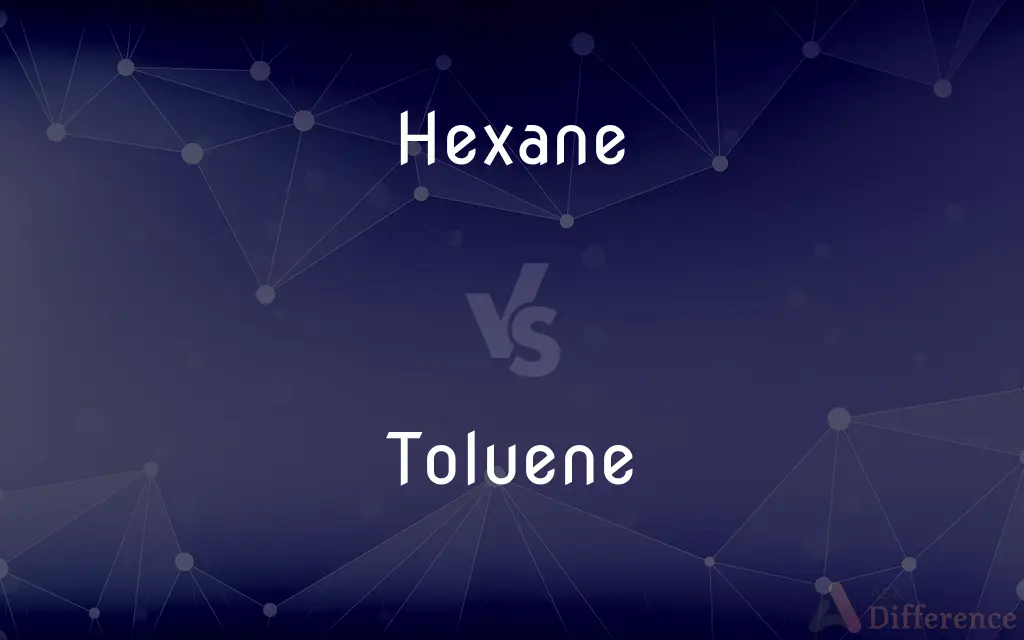Hexane vs. Toluene — What's the Difference?
Edited by Tayyaba Rehman — By Urooj Arif — Updated on April 3, 2024
Hexane is a straight-chain alkane with six carbon atoms, commonly used as a non-polar solvent, while toluene is an aromatic hydrocarbon with a methyl group attached to a benzene ring, known for its solvent properties and presence in gasoline.

Difference Between Hexane and Toluene
Table of Contents
ADVERTISEMENT
Key Differences
Hexane is characterized by its simple, straight-chain structure, making it a significant component in various industrial applications, especially as a solvent in the extraction of edible oils. Its non-polarity allows it to dissolve substances that are similarly non-polar. On the other hand, toluene features an aromatic benzene ring with a methyl group, contributing to its distinctive solvent capabilities that are favorable in the chemical industry, including in the manufacture of paints, glues, and nail polish removers. Its aromatic nature gives it different chemical properties and environmental impacts compared to hexane.
While hexane is primarily valued for its effectiveness in the extraction process and relatively low reactivity due to its saturated hydrocarbon structure, toluene is appreciated for its ability to dissolve a wide range of chemical substances, thanks to its aromatic structure. This difference in solvency power is crucial for industrial applications requiring specific solvent properties.
The health hazards associated with both chemicals also differ significantly. Hexane is notably neurotoxic, with exposure potentially leading to peripheral neuropathy among workers in industries where hexane is used extensively. Toluene, while less neurotoxic than hexane, poses its own risks, including respiratory issues and potential to cause central nervous system depression with acute exposure.
In environmental terms, both hexane and toluene are volatile organic compounds (VOCs), contributing to air pollution and possessing different degrees of impact on atmospheric conditions. However, toluene's presence in urban air, particularly from automobile emissions where it is used as an octane booster in gasoline, highlights its more prominent role in environmental concerns related to urban pollution and smog formation.
Despite these differences, both hexane and toluene share roles as crucial industrial solvents, with their selection dependent on the specific chemical and physical properties required for particular applications. Their widespread use underscores the importance of understanding their chemical behaviors, health risks, and environmental impacts.
ADVERTISEMENT
Comparison Chart
Structure
Straight-chain alkane (C6H14).
Aromatic hydrocarbon (C7H8).
Common Use
Solvent in edible oil extraction.
Solvent in paint, glue, and nail polish remover.
Solvency Power
Effective for non-polar substances.
Stronger due to aromatic structure.
Health Hazards
Neurotoxic, can cause peripheral neuropathy.
Respiratory issues, CNS depression.
Environmental Impact
VOC contributing to air pollution.
Significant role in urban pollution, smog formation.
Industrial Application
Less reactive, used in extraction processes.
Used in chemical synthesis, manufacturing processes.
Compare with Definitions
Hexane
A non-polar solvent used in industrial applications.
Hexane is utilized for extracting oils from seeds.
Toluene
Can cause respiratory issues and CNS depression.
Inhalation of toluene vapors can lead to dizziness and headaches.
Hexane
Straight-chain alkane with six carbon atoms.
Hexane's formula is C6H14.
Toluene
A solvent found in many consumer products.
Toluene is a key ingredient in nail polish removers.
Hexane
Characterized by low reactivity.
Hexane is chosen for reactions requiring a stable solvent.
Toluene
Contains a benzene ring with a methyl group.
The molecular formula of toluene is C7H8.
Hexane
Commonly found in laboratory settings.
Hexane is used to clean laboratory equipment of organic compounds.
Toluene
Used in manufacturing processes.
Toluene is utilized in making synthetic fibers.
Hexane
Known for neurotoxic effects with prolonged exposure.
Workers exposed to hexane vapor can develop neuropathy.
Toluene
Present in gasoline, contributing to urban pollution.
Toluene is used to boost octane levels in automotive fuels.
Hexane
Hexane () is an organic compound, a straight-chain alkane with six carbon atoms and has the molecular formula C6H14. Hexane is a significant constituent of gasoline.
Toluene
Toluene (), also known as toluol (), is an aromatic hydrocarbon. It is a colorless, water-insoluble liquid with the smell associated with paint thinners.
Hexane
A colourless liquid hydrocarbon of the alkane series, present in petroleum spirit.
Toluene
A colorless flammable aromatic liquid, C7H8, obtained from coal tar or petroleum and used in aviation fuel and other high-octane fuels, in dyestuffs, explosives, and as a solvent for gums and lacquers. Also called methylbenzene.
Hexane
Any of several isomeric colorless flammable liquid hydrocarbons, C6H14, derived from the fractional distillation of petroleum and used as a solvent and as a working fluid in low-temperature thermometers.
Toluene
(organic compound) A colourless, inflammable liquid hydrocarbon, methylbenzene, CH3.C6H5, used as a solvent, in high-octane fuels and in the production of many chemical compounds.
Hexane
(organic compound) Any of five isomeric aliphatic hydrocarbons, C6H14. They are colorless, volatile liquids.
Toluene
A hydrocarbon, C6H5.CH3, of the aromatic series, homologous with benzene, and obtained as a light mobile colorless liquid, by distilling tolu balsam, coal tar, etc.; - called also methyl benzene, phenyl methane, etc.
Hexane
Any one of five hydrocarbons, C6H14, of the paraffin series. They are colorless, volatile liquids, and are so called because the molecule has six carbon atoms.
Toluene
A colorless flammable liquid obtained from petroleum or coal tar; used as a solvent for gums and lacquers and in high-octane fuels
Hexane
A colorless flammable liquid alkane derived from petroleum and used as a solvent
Common Curiosities
What is hexane?
Hexane is a non-polar, straight-chain alkane commonly used as a solvent in industrial processes, particularly for extracting oils.
Can hexane and toluene be used interchangeably?
While both are solvents, their use depends on the specific requirements of the process, including solvency power and chemical reactivity.
How is toluene used in industry?
Toluene is widely used as a solvent in the manufacture of paints, glues, and nail polish removers, as well as in the synthesis of other chemicals.
How do hexane and toluene differ in their chemical structures?
Hexane is a straight-chain alkane with no aromatic rings, whereas toluene contains an aromatic benzene ring with a methyl group.
Are there safer alternatives to hexane and toluene?
In some applications, less toxic solvents can be used as alternatives, though the effectiveness and feasibility depend on the specific process requirements.
What are the health risks of hexane?
Prolonged exposure to hexane can lead to neurotoxic effects, including peripheral neuropathy, especially in industrial settings.
Why is toluene considered a health hazard?
Toluene exposure can cause respiratory issues and central nervous system depression, with symptoms like dizziness and headaches upon inhalation.
What measures can be taken to minimize health risks when working with these chemicals?
Proper ventilation, use of personal protective equipment, and adherence to safety protocols are crucial to minimize exposure and health risks.
What environmental concerns are associated with hexane and toluene?
Both are volatile organic compounds contributing to air pollution, with toluene particularly noted for its role in urban pollution and smog formation.
How do hexane and toluene contribute to air pollution?
As volatile organic compounds, both hexane and toluene evaporate into the atmosphere, contributing to the formation of ground-level ozone and smog.
Share Your Discovery

Previous Comparison
Outflux vs. Efflux
Next Comparison
Assemble vs. MakeAuthor Spotlight
Written by
Urooj ArifUrooj is a skilled content writer at Ask Difference, known for her exceptional ability to simplify complex topics into engaging and informative content. With a passion for research and a flair for clear, concise writing, she consistently delivers articles that resonate with our diverse audience.
Edited by
Tayyaba RehmanTayyaba Rehman is a distinguished writer, currently serving as a primary contributor to askdifference.com. As a researcher in semantics and etymology, Tayyaba's passion for the complexity of languages and their distinctions has found a perfect home on the platform. Tayyaba delves into the intricacies of language, distinguishing between commonly confused words and phrases, thereby providing clarity for readers worldwide.














































